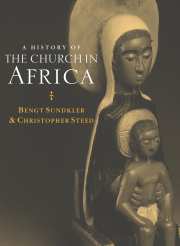Book contents
- Frontmatter
- Contents
- List of maps
- Acknowledgements
- List of abbreviations
- Introduction
- PART I THE FIRST FOURTEEN HUNDRED YEARS
- PART II THE MIDDLE AGES 1415 – 1787
- PART III THE LONG NINETEENTH CENTURY 1787 – 1919
- 3 Overview To The Nineteenth Century
- 4 North and North-Eastern Africa
- 5 Western Africa
- 6 West-Central Africa
- 7 Southern Africa
- 8 South-Central Africa and the Indian Ocean
- 9 East Africa
- 10 East-Central Africa
- PART IV THE COLONIAL EXPERIENCE 1920 – 1959
- PART V INDEPENDENT AFRICA 1960 – 92
- Notes
- Bibliography
- Name index
- Subject index
3 - Overview To The Nineteenth Century
from PART III - THE LONG NINETEENTH CENTURY 1787 – 1919
Published online by Cambridge University Press: 16 September 2009
- Frontmatter
- Contents
- List of maps
- Acknowledgements
- List of abbreviations
- Introduction
- PART I THE FIRST FOURTEEN HUNDRED YEARS
- PART II THE MIDDLE AGES 1415 – 1787
- PART III THE LONG NINETEENTH CENTURY 1787 – 1919
- 3 Overview To The Nineteenth Century
- 4 North and North-Eastern Africa
- 5 Western Africa
- 6 West-Central Africa
- 7 Southern Africa
- 8 South-Central Africa and the Indian Ocean
- 9 East Africa
- 10 East-Central Africa
- PART IV THE COLONIAL EXPERIENCE 1920 – 1959
- PART V INDEPENDENT AFRICA 1960 – 92
- Notes
- Bibliography
- Name index
- Subject index
Summary
TWO DIVERSE MAPS
A theme
Two quite different maps can be drawn for the nineteenth-century Christianization process in Africa: one explicit, manifest and official; the other – no less important – related to clan and village involved in the cataclysmic changes which overtook African societies.
The first, the official map, covered ‘mission fields’, consisting of a great
number of mission societies and mission stations, Catholic and Protestant, highly visible centres in the African landscape, with church, school, clinic, farm and printing press, together with staff houses. Such centres represented well-defined missionary programmes. From the station there were regular visits to the surrounding population by the Western missionary and/or the African catechists, by foot, on horse back, by ox cart, or by canoe.
In certain cases the mission station was seen as a point of departure for a strategic plan or dream, to reach farther afield. There were to be established so-called ‘chains’ of mission centres: six of them in a Methodist programme through Transkei designed by William Shaw; a Reformed chain along the south-west Namaqualand coast; or from Natal overland to Ethiopia; or across the continent from Mombasa to Gabon, devised by Johan Ludwig Krapf; or from Gabon to Mombasa, and planned by John Leighton Wilson.
- Type
- Chapter
- Information
- A History of the Church in Africa , pp. 81 - 123Publisher: Cambridge University PressPrint publication year: 2000



